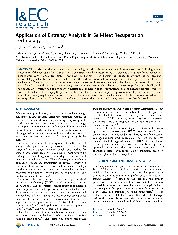摘要
Aside from the introductory and concluding remarks, this article is divided into four sections. Following a brief description of the concepts of entransy and entransy dissipation, which measures the irreversibility of heat transfer not related to heat-to-work conversion, a temperature-heat-flow-rate diagram (T-Q diagram) is applied to evaluate the heat-transfer irreversibility graphically, which can be used to reflect the performance of self-heat recuperation technology (SHRT) in chemical engineering. The entransy analyses in terms of temperature-heat-flow-rate diagrams for the chemical processes with gas and vapor/liquid streams show that a lower entransy-dissipation rate corresponds to better heat-recovery performance. Finally, both the quantitative entransy and exergy analyses indicate that, compared to the conventional self-heat exchange process, a process with SHRT achieved by changing the pressure of the effluent stream with a compressor provides much higher heat recovery and much lower energy requirement because of the much lower heat-transfer irreversibility measured by the entransy-dissipation rate or exergy-destruction rate. In addition, the differences between the entransy and exergy analyses are also discussed.
